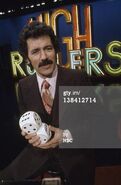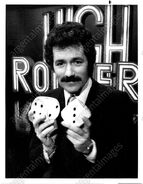| Aired | |
| Pilot: February 13-14, 1978 NBC Daytime, April 24, 1978-June 20, 1980 | |
| Run time | |
| 30 Minutes | |
| Host | |
| Alex Trebek | |
| Announcer | |
| Kenny Williams | |
| Origination | |
| NBC Studio 3, Burbank, California | |
This is chronicling the 1978 version of High Rollers. This version was also known as New High Rollers in the pilot and as (The New) High Rollers in the series.
Game Format[]
Two contestants competed, one of whom was a returning champion (or designate, if a previous champion had just retired). The objective was to remove numbers off a game board containing the digits 1 through 9 by rolling an oversized pair of dice. High Rollers was modeled on a traditional board game called Shut the Box.
In order to determine who gained control of the dice, the host asked a toss-up question with either multiple-choice answers, true/false answers, or "Yes" or "No" answers; whoever buzzed in with the correct answer won control; an incorrect answer gave the opponent control. The player in control could do one of two things:
- Roll the dice, an option usually taken only early in a game.
- Pass them, forcing his or her opponent to roll. This was by far the most common decision, especially as a game progressed, with fewer good rolls on the board (and since a bad roll automatically lost the game). However, if the odds of making a bad roll were low, such as a 3 or an 11, the player who won control of the dice could take the gamble and roll.
Players removed numbers from the board based on the value of the roll of the dice (either all by itself or in combinations). For example, if a 10 was rolled, the player could remove any of these combinations: 1-9, 2-8, 3-7, 4-6, 1-2-7, 1-3-6, 1-4-5, 2-3-5 or 1-2-3-4, which were all combinations that added up to 10. The digits were randomly arranged in three columns of three digits apiece, with each column containing up to five prizes. This new board ran on lights & slide projectors, and in each round, the numbers had varying colors and typefaces as well.
The prizes ranged from the usual game show gifts (e.g., furniture, appliances, trips) to offbeat, unusual prizes. Some of the more outlandish examples included the following:
- A collection of musical dolls.
- African masks.
- 12 portable televisions (one for the contestant and 11 for friends).
- A fully-catered gourmet banquet for 50 people.
- A trip to the Kentucky Derby with $100 bets on each horse.
- A fully-equipped built-in home aquarium (stocked with exotic fish).
- A $10,000 antique Chinese fishbowl, which was offered on the 1980 finale.[1]
Often, the value of a prize package reached $20,000, mostly exceeding that mark toward the end of this version.
One (very rarely, two) of the columns were called "Hot Columns", meaning that all three digits therein could be taken off by a single roll of the dice, thus claiming the prize(s) in that column. During this series, each column started with one prize, with another added to it at the beginning of each game until the package was won, or until the maximum of five prizes per column had been reached.
Only by eliminating the last digit in a column could a player add those prizes to his/her bank (regardless of who removed the others); as before, the contestant had to win the round to keep the prizes. Prizes that were banked but not won during a game were returned to their columns.
Contestants who rolled doubles (e.g., 2-2, 3-3, 4-4, etc.) earned an "Insurance Marker," which could be turned in for a free roll if they hit a bad number. However, if the doubles roll itself was a bad roll, the insurance marker was translated simply into another roll, which meant that a roll of 2 (aka "Snake Eyes" 1-1) and a roll of 12 (aka "Boxcars" 6-6) were the only safe rolls whether the number itself was on the board or not.
Play continued until:
- One player made a bad roll, meaning no combination of digits currently on the board could match that roll of the dice.
- One player took the last remaining digit(s) off the board (the rarer outcome).
The winner of the game kept any and all prizes in his/her bank; in the event the bank was empty, he/she won a "house minimum" of $100 (an additional prize in the pilot). The first player to win two games won the match.
The Big Numbers[]
In the bonus game, called the "Big Numbers", the champion attempted to knock off larger numbers on the gameboard. Insurance markers were still awarded for doubles. If all nine numbers were knocked off, that player won $5,000 & a new car ($10,000 in the pilot). Later shows offered just the car as the grand prize. The car was later dropped as a prize and the $5,000 was once again offered, with Trebek explaining that it was due to the energy crisis during the last few weeks of this version. If a contestant failed to eliminate all nine numbers, he/she received $100 for each digit that was eliminated from the board.
Players could stay until they lost or won seven matches.
| This page uses Creative Commons Licensed content from Wikipedia (view authors). |
Cancelled Merchandise[]
Milton Bradley was going to release a board game based on the 1978 version in 1979, but it ended up getting cancelled before it got manufactured.
Photos[]
Trade Ad[]
Episode Status[]
See Also[]
High Rollers
Lucky Numbers
High Rollers (1987)















